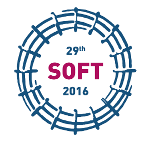Speaker
Takeo Nishitani
(National Institute for Fusion Science)
Description
The Large Helical Device (LHD) plans to start the deuterium experiment in March of 2017, where a maximum neutron yield of 2.1x101616 neutrons/3 sec is expected. For the deuterium experiment, neutron flux monitors, a neutron profile monitor, a neutron activation system and other neutron detectors have been prepared. The characteristics of those neutron diagnostics, such as the detection efficiency, the plasma position sensitivity and the special resolution, have been evaluated by the neutron Monte Carlo simulation using a three-dimensional model of LHD, where MCNP-6 Monte-Carlo neutronics code is used with the cross-section library of ENDF B-VI. In the MCNP calculation geometry, the LHD components within the helical coil support structure are divided by small toroidal angle pitch, and the components are assumed to be toroidally symmetric in a toroidal pitch angle. The geometry in one toroidal pitch angle is modeled based on the CAD drawing with some simplification. Three neutron flux monitors using a U-235 fission chamber with 50 mm-thick polyethylene moderator are located on the canter axis of LHD and at two toroidal location on the horizontal plane outside the cryostat. It is confirmed that the detection efficiencies for total neutron emission of the LHD plasma are almost insensitive to the source neutron energy in the range of 2-3 MeV, the plasma position and the neutron source profile. The neutron profile monitor consists of 11 channels of stilbene detectors with a parallel collimator embedded in the concrete floor slab. It is found that the crosstalk in the adjoining channels is smaller that 1%.
Co-authors
Kunihiro Ogawa
(National Institute for Fusion Science, Toki, Gifu, Japan;SOKENDAI (The Graduate University for Advanced Studies), 322-6 Oroshi-cho, Toki 509-5292, Japan, Japan)
Mitsutaka Isobar
(National Institute for Fusion Science, Toki, Gifu, Japan;SOKENDAI (The Graduate University for Advanced Studies), 322-6 Oroshi-cho, Toki 509-5292, Japan, Japan)
Takeo Nishitani
(National Institute for Fusion Science, Toki, Gifu, Japan)

